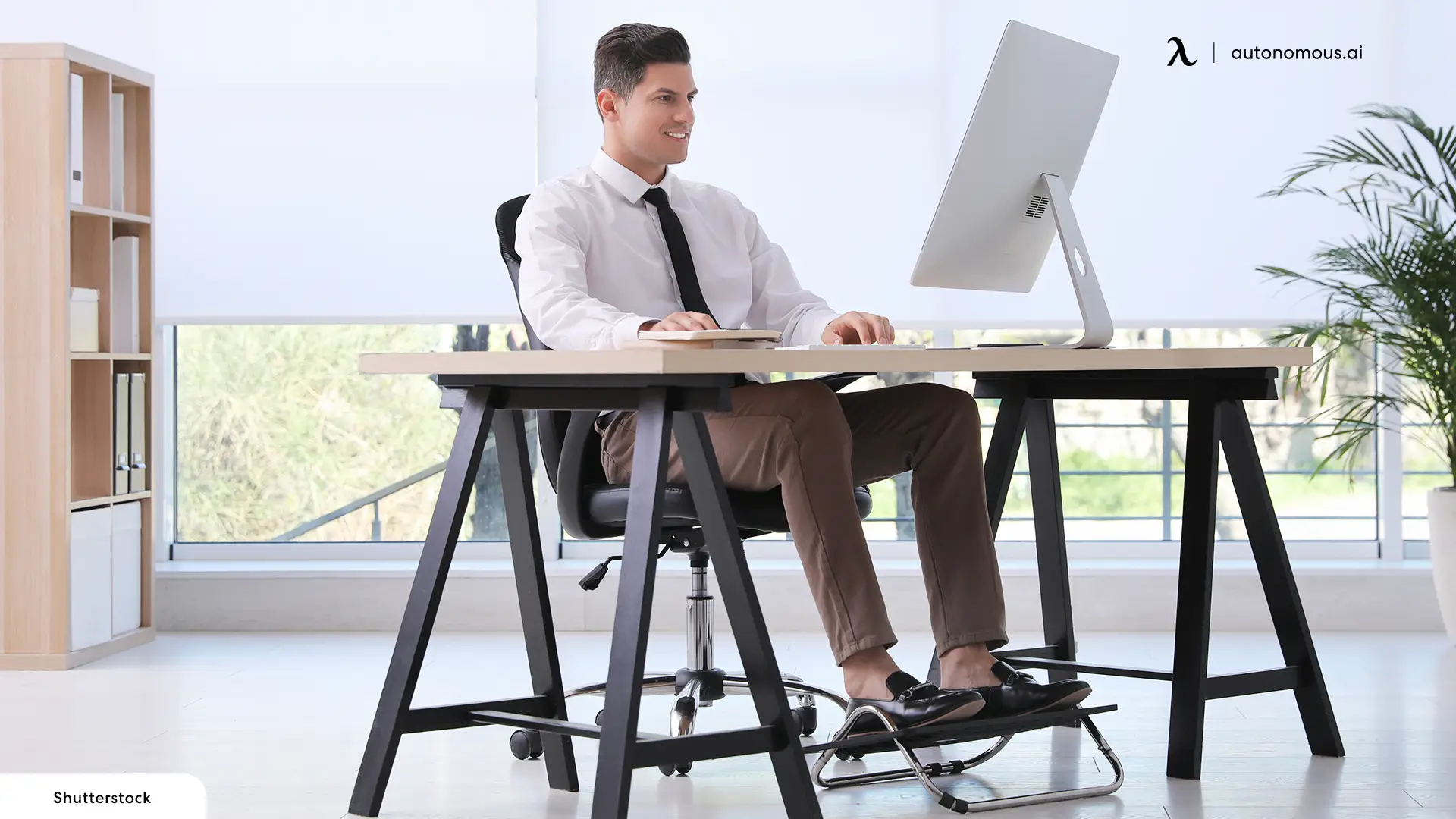
How to Elevate Your Legs While Sitting at a Desk
Table of Contents
It is essential to maintain a comfortable posture while sitting in an office chair for long hours to avoid serious health problems. However, were you aware that the position of your legs while sitting has a huge effect?
The goal of ergonomics is to design work environments that promote worker well-being and efficiency. Therefore, with the help of perfect ergonomic furniture and some healthy habits we can easily take care of our bodies. Let’s dive into the facts behind how to elevate your legs while sitting at a desk.
Why Do People Elevate Legs While Sitting at a Desk?
Long periods of sitting in an upright posture, exceeding the forty -five-minute advised time period, can be harmful. Impaired blood flow is associated with an increased likelihood of numbness, edema, varicose veins, muscle and tendon discomfort, and blood clots.
These are just a few of the numerous reasons why a lot of individuals elevate their legs while sitting:
- Improved Blood flow
If you want better blood circulation to your lower legs, try elevating them. Veins carry blood that has lost its oxygen content back to the heart. Your veins employ small valves, and the muscular contractions in the area assist in the return of blood to your heart. Even when you're not moving around much, gravity still forces blood that has lost oxygen to travel back to your heart through your elevated legs.
- Reduces Swelling
Accumulation of extra fluid (edema) or inflammation can cause swelling. When your legs swell, it could be because of an injury or a medical issue. Raising your legs from your computer chair with a footrest may facilitate the drainage of extra fluid in the same manner that it improves blood flow.
- Lowers Pressure
Blood can collect in the veins of the legs if you stand or sit for long periods. As a result, the pressure in these veins might rise, which can cause problems like varicose veins. When you know how to elevate your legs while sitting at a desk properly, any blood that has collected there can drain out, reducing the pressure in your legs. Sitting down with your legs up can also alleviate pressure and pain in weary feet, especially after standing for an extended period of time.

What is the Best Way to Elevate Your Legs: Important Things to Know
1. How Long Should You Elevate Your Legs To Reduce Swelling?
If you suffer from swelling in your legs, ankles, or feet, try elevating your legs for 30 minutes, three or four times daily. People with mild venous disease may only need to elevate their legs to alleviate some of the swelling. If you're suffering from more severe instances, you will need to take further steps and learn how to properly elevate your legs while working.
2. How High Should You Elevate Your Legs To Reduce Swelling?
Raising your legs off the ground helps with circulation, edema reduction, and venous drainage. The recommended height is 8 to 12 inches above your heart level, which is greater than 45 degrees. If you're experiencing edema in your lower limbs, try elevating your legs frequently.
3. How to Elevate Your Legs at Work
Finding a comfortable position is the most important factor in elevating your feet. The ideal position is to raise your legs so they are above your heart. The best reclining office chair with footrests or cushions can do the trick here.
If this arrangement isn't possible while you're at work, you can prop your legs up on a footstool, sofa, or standing desk. By knowing how to properly elevate your legs, you can mitigate the effects of gravity, improve blood circulation, and lessen the likelihood of leg tiredness.
4. How to Elevate Your Legs While Sitting at a Desk: What to Avoid?
- Elevating legs for too little time: Unfortunately, there is no quick fix, so raising your legs once or twice won't do the trick. The recommended intervals for elevating the legs are about 20-30 minutes 4-5 times a day.
- Bending your legs at the knee: The common belief is that supporting your thighs is sufficient, but don’t even think about dangling your legs from the ergonomic chair's edge. This may impair blood flow in your lower legs, making it more difficult for blood to return to your heart.
- Not raising your legs high enough: It's important to know how to elevate your legs while sitting and lift them off the ground as much as possible. That way, blood may flow back toward your heart at an angle that's just right for you.
Frequently Asked Questions
Where does the fluid go when you elevate your legs?
When you lift your legs, fluids can return to your heart more easily, which is the primary advantage of this exercise. Lowering the pressure in your injured veins will alleviate some of the pain.
What are varicose veins?
Varicose veins have malfunctioning valves that prevent the normal flow of blood. Due to this, blood starts to collect in the vein, which puts pressure on the vein walls. The veins will look twisted or bulging, and they will be purple or blue. Spider veins, on the other hand, seem more like tiny webs and are easier to spot. Neither of these issues is seriously harmful to your health.
Do varicose veins hurt?
Even while varicose veins could be annoying, they shouldn’t hurt. Get medical help right away if you feel a sharp pain shooting through your legs.
Can I elevate my legs for too long?
The most crucial piece of advice is to do everything in moderation. You should only raise your legs from the floor on occasion, not constantly. Remember to talk to your doctor before attempting leg elevation as well.
Under what circumstances should you not elevate the legs?
You should always use a cushion to protect your skin from sharp edges and corners when you elevate your legs on a table or desk. It's best to use office chairs with footrests.
Nerve damage, spider veins, bruises, and soreness in the legs are all possible outcomes. Additionally, the high pressure it applies hinders circulation to the area, making it counterproductive.
Ending Thoughts
Elevating your legs might improve your health in several ways. Some of the main advantages are enhanced blood flow, less inflammation, and reduced pressure in your leg veins. If you suffer from varicose veins or edema due to long hours of work, elevating your legs may assist. Additionally, it has the potential to aid in the prevention of postoperative blood clots.
Attempting leg elevation without proper back and leg support is risky, so it's important to know how to elevate your legs while sitting at a desk. Consult your physician before attempting leg elevation if you are suffering from any preexisting conditions.
Spread the word
.svg)







